Robert F. Barkley, DDS, in his book Successful Preventive Dental Practices, states that the following traditional dental education assumptions are incorrect: “An enlightened patient will become a good patient. Patients learn that which we teach. Patients learn at the same rate. Patients will learn quickly at the time of physical or financial threat.”1
Although many patients can be made aware of their need for treatment, they may elect not to proceed for a variety of reasons. Patients usually do not learn what we try to teach them, and various policies and procedures often make patients feel we are more interested in ourselves rather than them. A comprehensive examination is the best way to proceed with a new patient. However, the patient often perceives this recommendation as leading to more expensive treatment.1 Patients progress at different rates in their learning, and may allow all-inclusive rehabilitation at a later date if warranted. Sometimes phased treatment may be permitted that is not detrimental to the final result.1
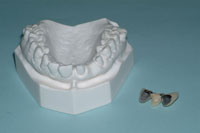 |
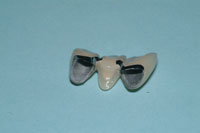 |
| Figure 1. Ceramo-metal bridge and model, demonstrating preparations. | Figure 2. Ceramo-metal bridge, internal aspect. |
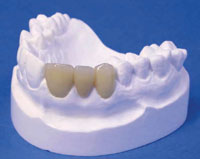 |
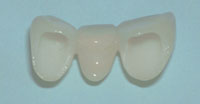 |
| Figure 3. IPS Empress bridge (Ivoclar Vivadent). | Figure 4. Translucency of IPS Empress bridge. |
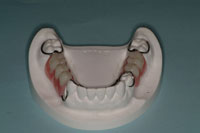 |
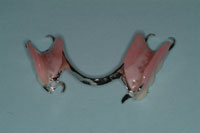 |
| Figure 5. Partial denture with metal clasps. | Figure 6. Partial denture demonstrating lingual bar. |
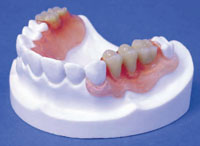 |
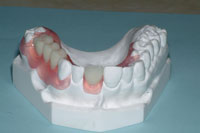 |
| Figure 7. Partial denture with Valplast clasps. | Figure 8. Partial denture with Valplast clasps for anterior missing tooth. |
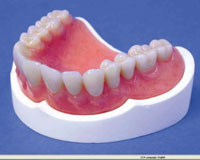 |
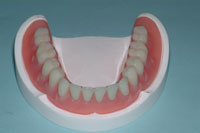 |
| Figure 9. Full maxillary denture. | Figure 10. Mandibular denture. |
Ideally, the initial examination should allow the patient to envision long-range treatment.1,2 At this stage, the dentist should try to ascertain what the patient wants and what is relevant to him or her. The doctor and patient should learn together the problems that exist in the patient’s mouth and the consequence of not treating.3 In the following visits, these findings can be discussed and options for treatment explored. The examination appointment should be used only for the purpose of obtaining a case history, comprehensive examination, charting, complete radiographs, vitality testing (if needed), and diagnostic models if warranted.3 Patient education can also be initiated. They should be made aware of existing conditions and any areas of neglect in their dental health. They can be given a mirror, or images of problem areas can be captured and presented on a computer screen. The advantage of the latter is the ability to magnify areas so that the patient can see better, and the presentation is technically more advanced. The patient’s desires in seeking treatment should be explored at this time. A case presentation should address these desires and explore treatment options.4
The time between the first and second visit allows the dentist to arrive at a diagnosis based on the clinical exam, radiographic findings, and study models.3 The treatment plan should be suitable for that particular patient. Some dentists only formulate one treatment plan, while others formulate several. If too many choices are presented, it may be confusing for the patient. The ideal treatment plan should be the first to be presented. Sometimes a holding plan is required if the patient cannot undergo optimal treatment due to financial, physical, or time constraints, but can proceed at a later date. A third alternative is to proceed with emergency treatment so as not to lose any teeth. The doctor should recommend the treatment that would be suitable for the doctor or his or her family. A fixed bridge, if suitable, should be recommended rather than a removable bridge. The desire for fine dentistry should be instilled at this time and at future visits.
At the case presentation the patient should become aware of the benefits of treat-ment.4 The patient should be able to visualize what the treatment will entail and how it will affect his or her health, appearance, and function. The patient should be made aware that he or she is paying for the treatment or services performed and not just for merchandise. Without education, patient comprehension or motivation will not occur.
A variety of tools can be used to explain treatment options. Photographs of similar cases are excellent, but models that demonstrate future treatment and that the patient can actually see and touch provide a more tactile sensation. Models that have been professionally fabricated (Sun Dental Laboratory) present an ideal way of demonstrating to the patient a variety of treatment alternatives. Models of the most common procedures are usually the best to obtain.3 Procedures that are increasingly being performed in the office can be added as needed.
A patient who presents with missing teeth can have one missing tooth, several missing teeth, or all the teeth missing or requiring extraction. A patient with one missing tooth in the anterior area can have the tooth replaced with an implant, a conventional ceramo-metal bridge (Figures 1 and 2), an all-ceramic bridge (Figures 3 and 4), a Maryland type bridge, or a removable bridge. The benefits and disadvantages of these can be explained to the patient. Ideally, one should be selected as the recommended treatment and the others as alternatives. The patient can be shown how the teeth have to be prepared for a fixed bridge (Figure 1) compared to an implant, where the adjacent teeth are not compromised. They can see the translucency to light of an all-ceramic bridge (Figure 4) compared to one that is metal-supported (Figure 2). Another alternative would be a removable partial denture with metal clasps (Figures 5 and 6), or one with gingival retentive arms (Figures 7 and 8). The patient can see how much display of metal occurs and also how much coverage of the palate may be required for the prosthesis. The impact of actually seeing these models can’t be underestimated.
If a patient is missing one or more posterior teeth, treatment options may include implants, a ceramo-metal prosthesis, sometimes an all-ceramic prosthesis, or a partial denture. By reviewing a model of a partial denture, for example, the patient can see how much material will be on the palate in the maxillary arch, or the bar on the lingual of the lower arch (Figure 6). The difference between a metal framework and one without can be demonstrated readily. When all remaining teeth need to be removed, it is devastating to the patient. Showing a full maxillary (Figure 9) or mandibular denture (Figure 10) removes the fear of the unknown. The aesthetics that could be achieved is readily realized, and problems with retention, especially in the lower arch, can also be appreciated. This can then lead to discussions of implants for fixed or overdenture-type attachments.
CONCLUSION
The more visual aids we provide the patient, the more often an increased understanding of the depth of treatment being offered can take place. Pictures, computer animations, and especially professional models all contribute to this comprehension. If it is presented to them appropriately, patients will allow more comprehensive treatment. They have to understand what dentistry can do for them and that optimal dental care may be financially feasible.3 This will be of great benefit to the patient’s long-term stability. Patients also appreciate the time clinicians spend explaining the options in a noncondescending manner.
References
- What’s wrong with patient education. In: Barkley RF. Successful Preventive Dental Practices. Macomb, IL: Preventive Dentistry Press; 1972:67-73.
- The treatment conference. Marketing for the Dental Practice. Milone CL, Blair WC, Littlefield JE. Philadelphia, PA: WB Saunders; 1982:204-219.
- Case presentation and motivation. In: Stinaff RK, ed. Dental Practice Administration. 3rd ed. St Louis, MO: Mosby; 1968:147-154.
- The convincing case presentation. In: Levoy RP. The Successful Professional Practice. Englewood Cliffs, NJ: Prentice-Hall; 1982:129-137.
Acknowledgment
Models provided by Sun Dental Laboratory.
Dr. Trushkowsky is a clinical associate professor of the CDE Advanced Aesthetic Program and associate director of international aesthetics, New York University College of Dentistry. He maintains a private practice in Staten Island, NY, and is a Fellow of the AGD, the Academy of Dental Materials, both the International and American College of Dentistry, and the Pierre Fauchard Academy. He is a lecturer in the ADA Seminar Series, an evaluator for CRA, and a senior consultant for The Dental Advisor. He wrote a chapter on direct composites in Mosby’s Esthetic Dentistry and a chapter on indirect restorations in Dental Clinics of North America. He has patents on 2 instruments for achieving contacts and curing posterior composites.He can be reached at (718) 948-5808 or composidoc@aol.com.



